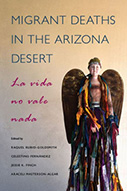MIGRANT DEATHS IN THE ARIZONA DESERT: LA VIDA NO VALE NADA

Editors: Raquel Rubio-Goldsmith, Celestino Fernández, Jessie K. Finch, and Araceli Masterson-Algar
Publisher: Tucson, AZ: University of Arizona Press, 2016. 302 p.
Reviewer: Nicolás Eilbaum | October 2017
Every year hundreds of migrants die while crossing the desert between Mexico and the United States. What does it mean that so many people die while trying to move from one country to another? How can we understand and humanize this regular stream of migrant deaths? Bringing together disciplines from sociology to poetry and much in between, Migrant Deaths in the Arizona Desert creates a multi-pronged framework to address these questions. Contributions range from the grim statistical compendium of the Pima County Medical Examiner’s Office to an all-inclusive catalogue and analysis of migration-themed songs (Fernández and Finch).
Section Four of the book zooms in on language—the images and metaphors used to describe migrant deaths. A “theology of the desert” tracing desert crossing back to its biblical sources (Nava) stands in contrast with a survey of newspaper metaphors used today (Zavisca). The “theology” reminds us of the prominent place of desert crossing in the Western imagination—crossing the desert as “primal” human behavior. The metaphors in today’s media coverage reveal we have moved from desert crossing as “great human story” to largely overlooking and de-humanizing migrant journeys today.
With many of the contributors affiliated with the University of Arizona in Tucson, the book is also an attempt to think of migrant deaths in the specific context of the Sonoran Desert. The authors may be writing from their “air-conditioned offices,” but they want to take responsibility for those dying of heat exposure all too close to them. Migration is not local—migrant deaths in Arizona are tied to global forces and national policies. But the book’s effort to interpret recent desert deaths in the context of Arizona’s history of “colonization, violence, and impunity” (Rubio-Goldsmith) and the border’s “cultural presence of death” (Griffith) still stakes a powerful claim to a local understanding of migrant crossing and death.
Borrowing from a classic Mexican song, the book’s subtitle (“La Vida No Vale Nada”) asks whether the migrant’s life has “no worth.” From the perspective of border policies designed to make border crossing more dangerous, the migrant’s life does seem to be worth very little. No number of migrant deaths may be large enough to make politicians reconsider the militarization approach to the border (Martínez). But policymakers de-humanize migrants in yet another way. In assuming that tighter border security will deter migrants from crossing, they underestimate the migrants’ vitality. The interview material from shelters near the border (Vandervoet and Ochoa O’Leary) introduces us to migrants who are determined to overcome any obstacles in their way.
The academic conference where the contributions to Migrant Deaths in the Arizona Desert were first presented took place in 2008. It is now 2017, and not much has changed. The current emphasis on building a wall along the Southern border doubles down on the militarized approach and is guaranteed to result in more dying. Migrant deaths are still largely invisible and seem to make no impact on immigration policy debates. At the heart of this book is an attempt to rescue migrants from the loneliness of “unmarked graves” (Lomnitz) and to somehow attempt to speak for the dead (Rubio-Goldsmith and Masterson-Algar). This ethical mandate is more relevant than ever.
Nicolás Eilbaum, Greensboro College


